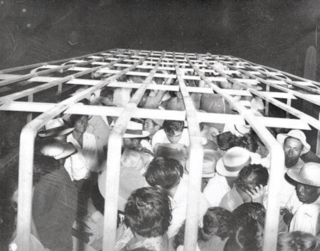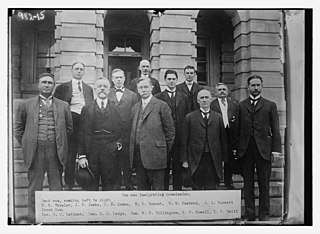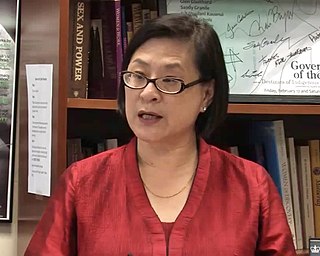
The Immigration and Nationality Act of 1965, also known as the Hart–Celler Act and more recently as the 1965 Immigration Act, is a landmark federal law passed by the 89th United States Congress and signed into law by President Lyndon B. Johnson. The law abolished the National Origins Formula, which had been the basis of U.S. immigration policy since the 1920s. The act formally removed de facto discrimination against Southern and Eastern Europeans as well as Asians, in addition to other non-Western and Northern European ethnic groups from the immigration policy of the United States.

The Immigration Act of 1924, or Johnson–Reed Act, including the Asian Exclusion Act and National Origins Act, was a federal law that prevented immigration from Asia and set quotas on the number of immigrants from Eastern and Southern Europe. It also authorized the creation of the country's first formal border control service, the U.S. Border Patrol, and established a "consular control system" that allowed entry only to those who first obtained a visa from a U.S. consulate abroad.

Operation Wetback was an immigration law enforcement initiative created by Joseph Swing, the Director of the United States Immigration and Naturalization Service (INS). The program was implemented in June 1954 by U.S. Attorney General Herbert Brownell. The implementation of Operation Wetback was a result of Attorney General Herbert Brownell's touring of Southern California in August 1953. It was here that he made note of the "shocking and unsettling" issue that was illegal immigration. The short-lived operation used military-style tactics to remove Mexican immigrants—some of them American citizens—from the United States. Though millions of Mexicans had legally entered the country through joint immigration programs in the first half of the 20th century and some who were naturalized citizens who were once native, Operation Wetback was designed to send them to Mexico.
Immigration reduction refers to a government and social policy in the United States that advocates a reduction in the amount of immigration allowed into the country. Steps advocated for reducing the numbers of immigrants include advocating stronger action to prevent illegal entry and illegal migration, and reductions in non-immigrant temporary work visas. Some advocate tightening the requirements for legal immigration requirements to reduce numbers, or move the proportions of legal immigrants away from those on family reunification programs to skills-based criteria.

Jeremiah Whipple Jenks (1856–1929) was an American economist, educator, and Professor at Cornell University, who held various posts in the US government throughout his career. He served as a member of the Dillingham Immigration Commission from 1907 to 1914 in which he led research projects on the state of immigration to the United States.

The Immigration and Nationality Act of 1952, also known as the McCarran–Walter Act, codified under Title 8 of the United States Code, governs immigration to and citizenship in the United States. It came into effect on June 27, 1952. Before the Immigration and Nationality Act of 1952, various statutes governed immigration law but were not organized within one body of text. According to its own text, the Act is officially entitled as just the Immigration and Nationality Act, but it is frequently specified with 1952 at the end in order to differentiate it from the 1965 law.

Saskia Sassen is a Dutch-American sociologist noted for her analyses of globalization and international human migration. She is a professor of sociology at Columbia University in New York City, and the London School of Economics. The term global city was coined and popularized by Sassen in her 1991 work, The Global City: New York, London, Tokyo.

Joseph Adna Hill (1860–1938) was an American statistician.

Foreign nationals (aliens) can violate US immigration laws by entering the United States unlawfully or lawfully entering but then remaining after the expiration of their visas, parole, TPS, etc. Illegal immigration has been a matter of intense debate in the United States since the 1980s.
The War Brides Act was enacted to allow alien spouses, natural children, and adopted children of members of the United States Armed Forces, "if admissible," to enter the U.S. as non-quota immigrants after World War II. More than 100,000 entered the United States under this Act and its extensions and amendments until it expired in December 1948. The War Brides Act was a part of new approach to immigration law that focused on family reunification over racial exclusion. There were still racial limits that existed particularly against Asian populations, and Chinese spouses were the only Asian nationality that qualified to be brought to the United States under the act. Additionally, the War Brides Act was well supported and easily passed because family members of servicemen were the recipients, but there were concerns over marital fraud which caused some tensions.

A Form I-766 employment authorization document or EAD card, known popularly as a work permit, is a document issued by the United States Citizenship and Immigration Services (USCIS) that provides temporary employment authorization to noncitizens in the United States.
The Ann Arbor Hospital murders were the murders of 10 patients by unauthorized administration in their IV of the curare drug Pavulon in an Ann Arbor, Michigan, VA hospital in 1975. After a vast FBI investigation into the deaths, the nurses Filipina Narciso and Leonora Perez were charged with murder but convicted only for the charges of poisoning and conspiracy. Public opinion was against prosecution of the nurses on the basis that they could have had only the most trivial of possible motives for conspiring to commit such extremely serious crimes, and the case was dropped after a retrial had been ordered.

Legislation seeking to direct relations between racial or ethnic groups in the United States has had several historical phases, developing from the European colonization of the Americas, the triangular slave trade, and the American Indian Wars. The 1776 Declaration of Independence included the statement that "all men are created equal," which has ultimately inspired actions and legislation against slavery and racial discrimination. Such actions have led to passage of the 13th, 14th, and 15th Amendments to the Constitution of the United States.

The United States Immigration Commission was a bipartisan special committee formed in February 1907 by the United States Congress, President of the United States and Speaker of the House of Representatives, to study the origins and consequences of recent immigration to the United States. This was in response to increasing political concerns about the effects of immigration in the United States and its brief was to report on the social, economic and moral state of the nation. During its time in action the Commission employed a staff of more than 300 people for over 3 years, spent better than a million dollars and accumulated mass data.

Mae Ngai is an American historian and Lung Family Professor of Asian American Studies and Professor of History at Columbia University. She focuses on nationalism, citizenship, ethnicity, immigration, and race in 20th-century United States history.

Shanghai Girls is a 2009 novel by Lisa See. It centers on the complex relationship between two sisters, Pearl and May, as they go through great pain and suffering in leaving war-torn Shanghai, and try to adjust to the difficult roles of wives in arranged marriages and of Chinese immigrants to the U.S. This work marks a return to many of the themes the author addressed in her first major work, On Gold Mountain, a memoir of her family's history. The novel is set between 1937–57 and matches Parts IV and V of the memoir.
Yamataya v. Fisher, 189 U.S. 86 (1903), popularly known as the Japanese Immigrant Case, is a Supreme Court of the United States case about the federal government's power to exclude and deport certain classes of alien immigrants under the Immigration Act of 1891. The Supreme Court held that the courts may not interfere with a pending deportation unless the administrative hearing was unfair. However, deportation procedures are subject to constitutional scrutiny, under the Due Process Clause.
Lucy E. Salyer is a professor of history at the University of New Hampshire known for her work on the history of immigration law in the United States.

Madeline Y. Hsu is an American historian known for her scholarship in Chinese American and Asian American history. She is an elected Fellow of the Society of American Historians. She is the eldest granddaughter of the neo-Confucian scholar Xu Fuguan.












